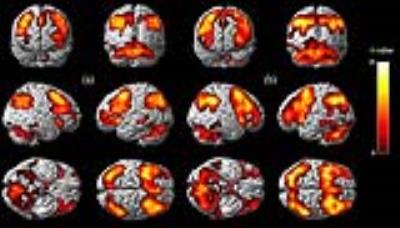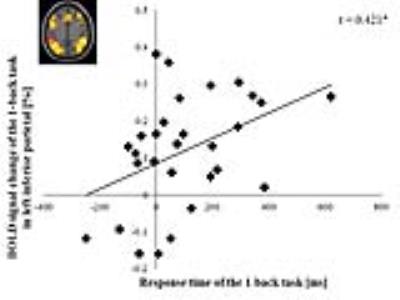4588
Neural correlates of cognitive load on working memory in organic-solvent exposed brain using fMRI1Medical & Biological Engineering, Kyungpook National University, Daegu, Korea, Republic of, 2Institute of Biomedical Engineering Research, Kyungpook National University, Daegu, Korea, Republic of, 3Daegu Kyungpook Medical Innovation Foundation, Daegu, Korea, Republic of, 4Radiology and Molecular Medicine, College of Medicine, Kyungpook National University, Daegu, Korea, Republic of
Synopsis
Several neuroimaging studies demonstrated that solvent-exposed subjects showed significantly poor performance on the working memory task than did controls [1,2]. However, no investigations have examined how solvent-exposed subjects are influenced by the cognitive load of a working memory task. Therefore, we performed N-back tasks with different cognitive demands using fMRI to investigate the neural basis for possible association between working memory load and memory deficit in the subjects with neurotoxicant solvent exposure. We found a positive correlation between response time of the 1-back task and percent BOLD signal changes in the left inferior parietal cortex, but a positive correlation was not founded of the 2-back task.
Purpose
In the present study, we used fMRI to assess the neural correlates of organic-solvent induced working memory impairment with different cognitive demands in solvent-exposed subjects chronically exposed to solvents with subclinical dysfunction in working memory.Methods
Twenty-nine right-handed solvent-exposed subjects (45 ± 6 years) who had worked in plants using organic-solvent more than 5 or more years were included in this study. Each participant concluded the verbal N-back task with the higher load conditions (1-back and 2-back) and baseline condition (0-back) during the fMRI acquisition. BOLD functional images were acquired using a Philips 3T Achieva with a 8channel SENSE head coil (EPI, TR=3000ms, TE=30ms, FOV=24cm, Matrix=68x68, NPy=68, Thickness=4.0mm, no gap, 96 volume, Scan time=5min). 3D T1-weighted anatomical image was obtained for structural reference (MPRAGE, TR=8.1ms, TE=3.7ms, FA=7, 1mm3 isotropic scan). Image processing and statistical analysis for fMRI data were performed using MATLAB and SPM8. The pre-processed fMRI data were then entered into individual analysis and within-group analysis and between-group analysis were thresholded at P < 0.01, false discovery rate (FDR) corrected for multiple comparisons across the whole brain. Pearson correlation analysis were performed using SPSS software. Statistical significance was defined at P < 0.05.Results
Within-group analysis showed fronto-parietal networks were activated in each 1-back and 2-back task (Figure 1). Direct comparisons between 1-back and 2-back task showed higher activation during the 2-back than the 1-back task in the bilateral DLPFC, IPC, and cerebellum (Figure 2). The increased percent BOLD signal change and increased behavioral response time of the 1-back task showed a strong positive correlation in the left inferior parietal cortex (Figure 3). However, the 2-back task required higher cognitive load was not founded for any of the activated brain areas such a positive trend.Discussion
The present study’s goal was to investigate activation patterns using the N-back task with varying levels of cognitive load in individuals with chronic occupational exposure to organic-solvent. Our findings of higher activation in brain regions with increased cognitive load is consistent with previous studies that increasing working memory load is generally associated with increased activation of that bilateral frontal and parietal cortex [3]. We also identified a positive correlation between response time and percent BOLD signal changes in the left inferior parietal cortex of the 1-back task, but a positive correlation was not founded of the 2-back task. This indicated that the increased recruitment in the left inferior parietal cortex at lower cognitive load task (1-back) is related with increased cost of the performing that. At higher cognitive load task (2-back), however, since the neural activation in the solvent-exposed subjects resulted in a ceiling effect, there are no association between the utilization of neural resources and the performing task.Conclusion
Increasing working memory processing load is related to increased activation in bilateral fronto-parietal networks. We also found that increased activation in the left inferior parietal cortex at lower cognitive load task (1-back) is associated with increased cost of implementing, but not founded of the 2-back task.Acknowledgements
No acknowledgement found.References
1. Haut MW, et al. Verbal working memory and solvent exposure: a positron emission tomography study. Neuropsychology (2000) 14: 551-558.
2. Tang CY, et al. Occupational solvent exposure and brain function: an fMRI study. Environ Health Perspect (2011) 119: 908-913.
3. Braver TS, et al. A parametric study of prefrontal cortex involvement in human working memory. Neuroimage (1997) 5: 49-62.
Figures


